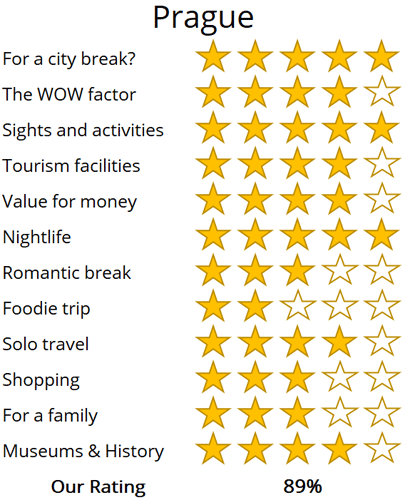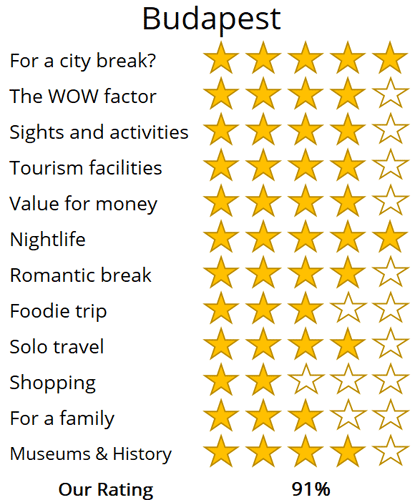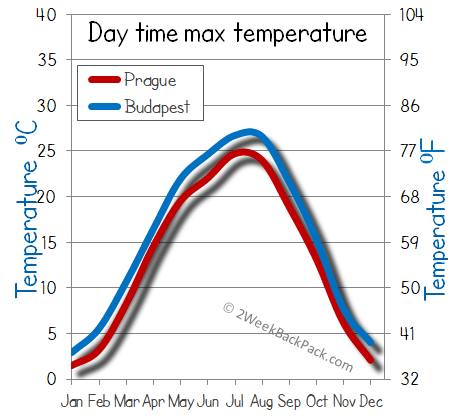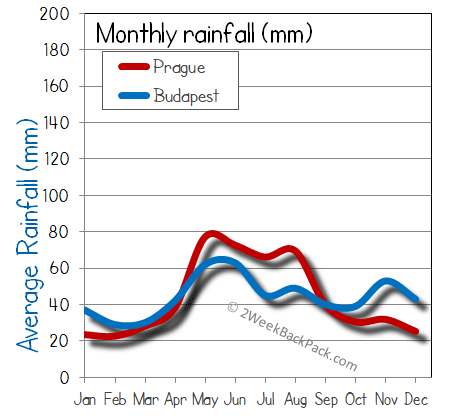WhereToGoForMyHoliday.com
The best destination comparison site!
WhereToGoForMyHoliday.com
The best destination comparison site!
Prague or Budapest, which is better for your holiday in 2024?
Prague and Budapest both offer unique and enticing experiences, but which one should you choose for your city break or holiday?
We recognise the difficulty in making this decision. While there is abundant information available on both destinations, clear guidance on which city better aligns with your travel preferences is often hard to find.
This article aims to provide an impartial comparison of Budapest and Prague, and hopefully help you to choose the best city to visit.
The article is structured into several sections, each of which can be directly accessed through the following links:
• Introduction to the cities
• Scores and ratings
• Which one should I, friends, or family visit?
• When to visit and weather
• Who is the city suited for?
• The perfect 48hours (with map)
• Tourism details (where to stay? airport details?)
Introduction to Prague and Budapest
Prague, the Czech capital wows visitors with its Gothic castles, cobbled lanes and handsome medieval plazas.It sits on a snaking bend in the Vltava River, unfolding with a fairy-tale Old Town district that flits from curious astronomical clocks to age-old synagogues at just the turn of a corner.
Around that are other neighborhoods that beat with hipster cafes or come topped with the stunning spires of Prague Castle – one of the largest medieval fortifications in the world.
You can fill days glugging frothy beers in cosy basement bars. You can trace the footsteps of Franz Kafka in award-winning literature museums. You can delve into enchanting Christmas Markets or gaze at great monuments on Wenceslas Square.
What's more, Prague sits smack bang in the heart of the beautiful region of Bohemia, a land of undulating hills and beer breweries that offers a taste of rural Europe.
Straddling the snaking Danube in the very heart of Europe is Budapest, the buzzing capital of Hungary.
Here, a city of two halves – Buda and Pest – unites to form a complex tapestry of over 1.7 million lives. With grand 19th-century bridges stitching together the landscape, Budapest entices with its blend of storied history, striking architecture, café charm, and lively nightspots.
Whether your eyes are drawn to the regal palaces atop Buda Hill or the heady aroma of sulphur from steaming bathhouses, Budapest never ceases to captivate. Venture into ruin bars, gaze upon the monumental Dohány Street Synagogue, or stroll the wide boulevards left behind by the Communist era.
In Budapest, every glance reveals a new layer of intrigue, a city where the past and present are locked in an endless dance.
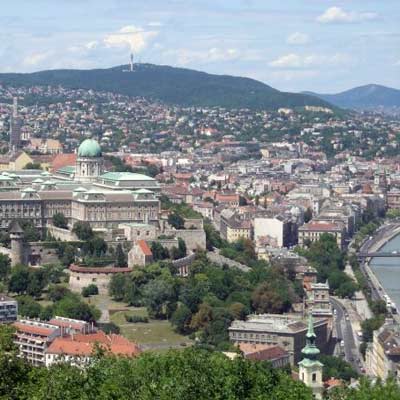
Budapest is a vibrant and modern city just waiting to be explored

The main square in Prague with the Tyn Cathedral
High-level summary Prague and Budapest
Summary
Where would I journey for a personal escape?
Budapest
Where would I send my parents for a memorable visit?
Prague
Where's the ideal destination for my adventurous 19-year-old cousin?
Budapest
Where should my food-obsessed friend indulge their culinary passions?
Budapest
Note: The above comparisons are weather-independent and are based on travel during the most opportune times of the year. Details about the ideal travel seasons are elaborated upon later in this article.
In the sections that follow, you'll find a comprehensive comparison between these two fascinating cities. This includes recommendations on the duration of stay, the best times to visit, and tailored 48-hour itineraries for each city.
The final segment delves into practicalities for your travels, such as the best airport to fly into, the optimal districts for your accommodation, and insider tips, for when you come to explore the city.
We hope that you find all of this information useful, in planning your next exciting trip!
Destination details
How long to spend each city?
Fly-in visits for three days are enough to check off the major must-see sights of Budapest. This is a compact capital with good underground and bus links. You can get easily get across town – going from Buda Castle on one side of the city all the way to the Széchenyi Thermal Baths at the other takes less than an hour on public transport.
That said, Budapest has plenty of hidden secrets up its sleeve. You could easily while away a whole week enjoying cheap happy hours in the ruin bars, bathing in the Art Deco spas, and visiting islands up the Danube. If you're coming in summer, you could also extend a stay to include the art galleries and cobbled lanes of Szentendre, the mineral-rich waters of Lake Balaton, and the rustic Tokaj wine country to the east.
Prague is one of the original European city break destinations. With countless low-cost carriers whizzing in and out, it should be easy to put together a short trip here on a budget. To unearth the secrets of the Old Town, see Prague Castle, and enjoy at least a night on the beer and the goulash, a few days is probably all you'll need.
Of course, if you've got extra days, Prague will surely fill them. Excursions out to the wooded valleys of Bohemia, where the castles of Český Krumlov and Kutna Hora await, can be added into the mix. But you could also stay in the city itself, to break away from the more touristy centre into neighborhoods like hipster Žižkov and Nusle.
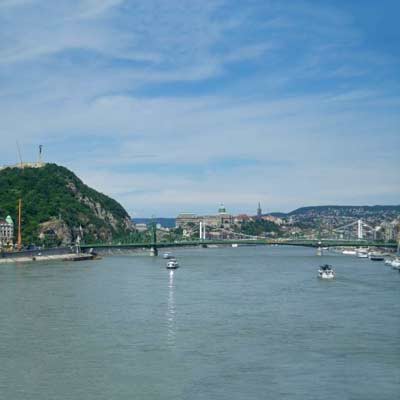
The mighty Danube River cuts Budapest in two

The delightful Prague Orloj is the world’s oldest operating astronomical clock, and displays the position of the Sun and Moon
Prague has the usual four seasons of Central Europe. The summer is generally hot and humid, with the highest temperatures in the 30s during July and August. It's also common to have regular thunderstorms that last for short bursts then. Winter, meanwhile, is cold. It's the best time to visit Prague if you're in search of kitschy Christmas markets that sell blood sausages, hot chocolate and warm Czech beer. You'll certainly need the thermals and snow coat between November and March, though. It's not uncommon for temperatures to stay below zero for weeks on end.
The upshot is that the spring and autumn probably see Prague in its prime. In April, May, September and October, things can still be mild and warm. There are fewer visitors hitting the mainstay sites like the Prague Castle. Hotel rates drop considerably to boot, and you're more likely to get bargains on flights into town.
Late spring and early autumn are when locals often say Budapest is at its best. Temperatures average around 23-25 degrees in May and September. There's not an overload of rain then either. And it's perfect for avoiding the crowds of midsummer city breakers that come during the European holidays.
There's also something to be said for visiting Budapest in the midst of winter. Mercury plummets between November and March, and it's not uncommon to see the Danube freeze over with huge chunks of ice. What's more, the tenements and side streets of the Jewish Quarter and the historic Inner City areas ooze atmosphere on cold, snowy days. Just be sure to pack the thermals!
Budapest, with its rich historical culture, intertwined seamlessly with an energetic nightlife, has established it as a top destination for a diverse range of travellers. Backpackers gravitate towards the Jewish Quarter's unique ruin bars, where they can indulge in exceptionally affordable Hungarian beers amidst eclectic courtyards.
Meanwhile, those with a cultural focus may choose to delve into the history of the Hungarian empire at Buda Castle or pay homage at the poignant House of Terror museum, which delves into the oppressive Stasi era.
However, if your preference leans towards sun-soaked beaches, Budapest might not feel like a perfect fit. Situated in a landlocked region, both the city and the country are devoid of coastline. Furthermore, while there are parks, they are predominantly located on the city's periphery, making Budapest predominantly an urban experience.
Prague is a heritage-rich, historic and hedonistic European city. You'll spend your time gawping at haunting castles and getting lost in medieval districts. Of course, there's also plenty of room for evenings of Czech beer and samplings of Slavic dumplings and goulash. If you're a food-loving culture vulture then there's hardly anywhere better on offer. What's more, backpackers and partygoers will find loads to like in the sleepless basement bars and pubs.
What Prague can't excel in is proximity to the ocean. If you're looking for somewhere to dine on seafood and hit the beach, it's not the place for you. The same goes for the great outdoors. It isn't hard to escape to backcountry Bohemia from here, but you will need to rent a car or organise a day trip away from the Old Town to do that.

The Charles Bridge spans the Vltava River in central Prague and is lined the thirty Baroque statues
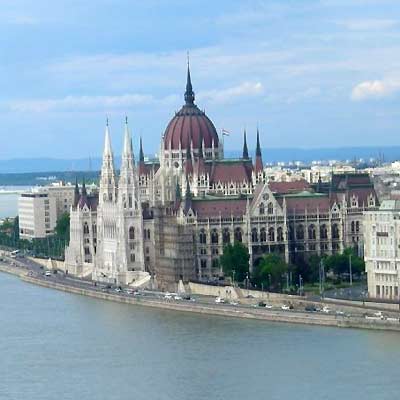
The Hungarian Parliament stands as a stunning testament to Budapest's architectural grandeur, holding the title of the city's tallest building
48hours in Budapest
Day 1: Begin your journey on the Pest side of the city, where the magnificent Dohány Street Synagogue resides. This landmark is not only pivotal to Budapest but also stands as the largest synagogue in Europe. Following this, take a stroll along Andrássy Avenue, a grand boulevard and UNESCO World Heritage site, adorned with Neo-Classical mansions.
Delve into Hungary’s tumultuous history with a visit to the House of Terror museum, situated at one end of the avenue. Subsequently, unwind with a spa session at the renowned Széchenyi Baths, celebrated for its Art Deco architecture. Cap off the day with a hearty dinner at Gettó Gulyás, indulging in their signature paprika-smoked goulash, and conclude your evening with a drink at Szimpla Kert, a mesmerizing art gallery turned bar.
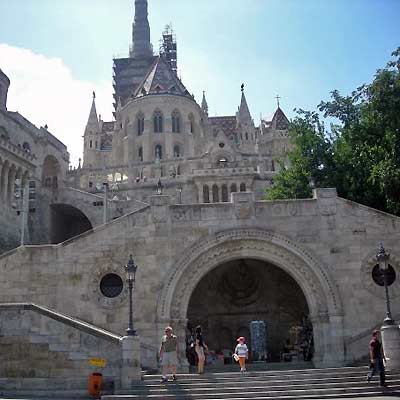
Pest cathedral
Day 2: Start your day with breakfast at the historic Central Market Hall, established in 1897. Savour the taste of sweet Hungarian pastries before crossing the Danube via the striking Liberty Bridge.
Upon arrival, you have the option to visit the elegant Gellért Baths or continue your journey to the Fisherman's Bastion and the Citadella, former military strongholds that now offer breathtaking views of the Danube. A northward stroll leads you to the Castle District, where you can either admire the architecture from the outside or explore the regal court rooms inside.
Don’t miss the chance to capture some photos of the imposing Hungarian Parliament Building across the river. Conclude your day with dinner in the Inner City of Pest, offering a diverse range of dining options from Tex-Mex restaurants to atmospheric 1930s speakeasies.

Gellért Hill offers some of the best views of Budapest, the hill is named after Saint Gerard who was murdered in 1065 by being put in a barrel and rolled down the hill…
48hours in Prague
Spending two days in Prague allows for a perfect balance between exploring its historical wonders and delving into its vibrant urban life. The enchanting Old Town and the imposing Prague Castle splendidly represent the city's rich history, while trendy districts such as Žižkov offer opportunities to enjoy coffee and scour through the markets.
Day 1: Start your weekend right in the heart of the city at the expansive Old Town Square, the central hub of Prague's historic quarter. It remains lively throughout the year, bustling with visitors meandering between significant landmarks such as the Old Town Hall and the Church of Our Lady before Týn. Notably, the church is renowned for its striking black Gothic turrets, towering over 80 metres tall.
Meanwhile, the Old Town Hall boasts stunning Gothic doors and gargoyles, and is home to the unique Prague Astronomical Clock. This 15th-century timepiece is the oldest functioning astronomical clock worldwide, drawing crowds every hour to witness its charming chime and the procession of apostles.
Continue east through the Old Town's intricate alleyways until you reach the riverside, leading directly to the iconic Charles Bridge. Adorned with statues of saints, it offers picturesque scenes, especially in the misty winter mornings. Cross over to Malá Strana, Prague’s oldest district, filled with traditional beer taverns such as the popular U Hrocha.
After a refreshing beer, it's time to ascend to Prague Castle, conveniently located steps away from the tavern. Dedicate your afternoon to exploring this vast complex, ranging from the magnificent St. Vitus Cathedral to the quaint workshops of Golden Lane.

The Dancing House may be one of Prague’s most distinctive buildings, but being in the heart of the old town its unique design was extremely controversial
Day 2: Treat yourself to a hearty breakfast in boho Žižkavárna Café. It's loved by the locals for its strong coffees and homemade cakes but is also a fantastic intro to the stylish neighborhood of Žižkov itself. The landmark at the heart of that district of the soaring Žižkov Television Tower in Tower Park Praha. Be sure to take in its futuristic architecture from below before going inside. Then, it's straight up to the observation decks to enjoy sweeping views of the city.
You'll also want to drop by the National Memorial on Vítkov Hill. It's an important spot in the annals of Czech history. It was once a hops plantation but now hosts the colossal equestrian statue of Jan Žižka (a revered Czech military general) and the Tomb of the Unknown Soldier, a symbolic monument to resistance to Nazi occupation.
Keep going north across the river to Prague 7 and you'll find stripped-down hipster cafés like Kavárna Liberál. For dinner, try the multi-ethnic stalls of Hala 22 closer to the waterside, where everything from Rajasthani curry houses to Chinese noodles are options. Finally, get your beer drinking hat on, because Gyllene tigern – a legendary microbrewery – beckons with its hoppy unpasteurized tipples back in the Old Town.

The Klaus synagogue and cemetery, in the Jewish quarter of Prague
The Václav Havel Airport Prague is the main entry point to the Czech capital. It's also the largest international airport in the Czech Republic. That means short-haul flight connections arrive there from all over, and you can usually bag some wallet-friendly bargains on carriers like Ryanair and EasyJet
For a European capital, Prague is very walkable and bikeable. The whole Old Town is actually best explored on foot, and the same goes for the castle district. For longer trips, the uber-efficient Prague Metro and tram network combine on the PID ticket to offer easy hops from A to B.
The basic ticket costs 24 CZK ($1) and allows access and transfers for 30 minutes. Buy them via the Prague transport mobile app, in local newsagents, or at the tram stops themselves. Don't forget to validate your ticket at the yellow machines on board.

The Gothic Saint Vitus Cathedral lies within the Prague castle complex
All the usual crimes and scams of a European capital are present in Prague, though the town is generally very safe for visitors. Be vigilant of pick pocketers in busy areas and on public transport especially. Also try to dodge picking up taxis straight off the street – tourists are often prime targets for inflated rates. Prague's currency exchange points are notorious for being rip offs, so get your koruna before touching down.
For proximity to the main sites and bars, there's really nowhere better to bed down than in the Prague Old Town. Hotels will usually cost the most there, however. Something quieter and equally as atmospheric is available in the Malá Strana. But the New Town district and Žižkov are also both good options.
Travelling to and around Budapest is super easy. There's an efficient underground network. Tickets for that cost 350 HUF per ride with a single transfer allowed. You can also use river boats (HUF750 per journey) and buses (350 HUF).
Taxis are rarely needed, but they are cheap, costing 280 HUF per kilometer. Be sure to insist your driver puts the meter on, and never accept offers from taxi touts at the airport.

The Fisherman's Bastion, Budapest
Talking of the airport, Budapest Airport sits around 22 kilometers from the city center. You can get to and from the terminals using the dedicated express bus (€2) or by train (€2.70). Both options take between 30-40 minutes. Be sure to buy tickets at machines by the stops – they're more expensive when purchased direct from drivers.
When it comes to picking hotels in Budapest, you're best off focussing on the Pest side of the city. That's where the bulk of the best lodgings are located. Being in the Jewish Quarter can be noisy, but perfect if you want to hit the nightlife of Szimpla and the other ruin bars. The Inner City area is charming and quieter, with some boutique options. Meanwhile, Újlipótváros is a local's favourite, with its cool cafés and art galleries and sleek Airbnbs.
Related articles: Where to stay in Budapest
Budapest is largely safe and crime statistics are in line with European norms. Some well-known scams include taxi drivers who overcharge and sellers of fake goods. Pickpocketing is also a rare but real problem. Just be aware of your personal possessions and be vigilante, especially when on public transportation.
Price wise, Budapest is surely up there with the cheapest of European capitals. A large beer can cost as little as 500 HUF (€1.50). Food in a midrange restaurant will set you back between 2,000 HUF and 3,000 HUF (€6-9). Nights in hotels are noticeably less than in nearby Vienna, too.
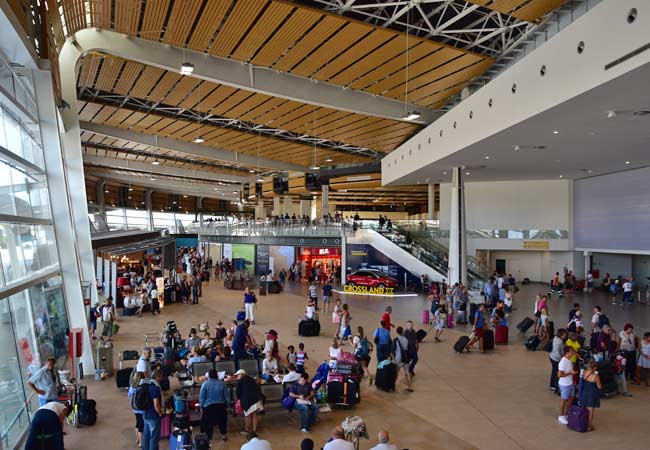
oh we were stuck in the airport!

Copenhagen was a bit expensive...

All we did was drink beer in Brussels...
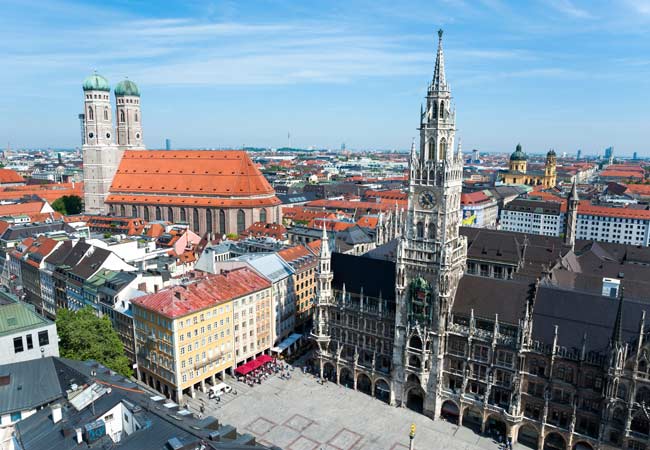
Muncih was crazy
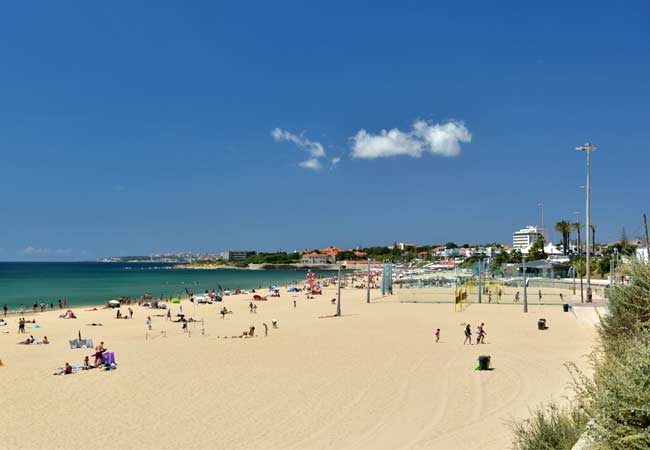
And we got so burnt!
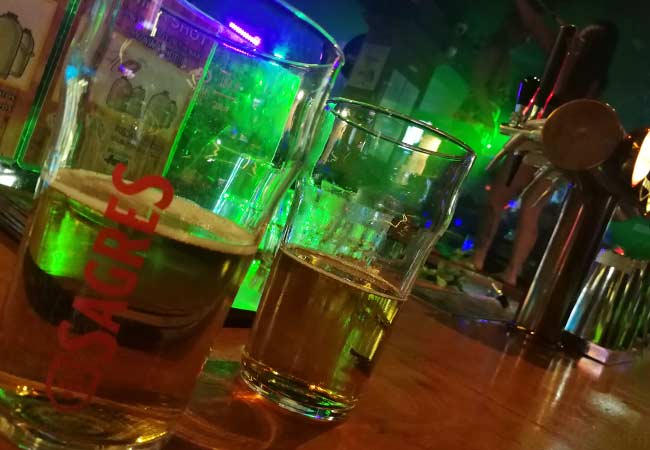
Remeber that night in Rome

oh we were stuck in the airport
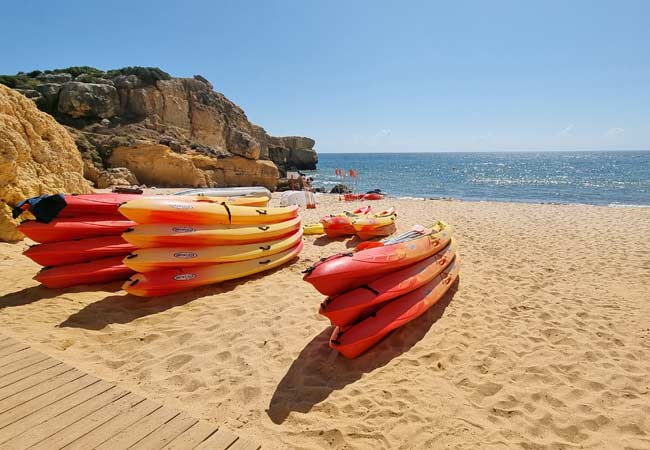
So much fun kayaking

Berlin and that group from Austria!

There was such a view from that church

And we got so burnt!

Munich was eventful, wasn't it!

Such a view from that cathedral in Florence
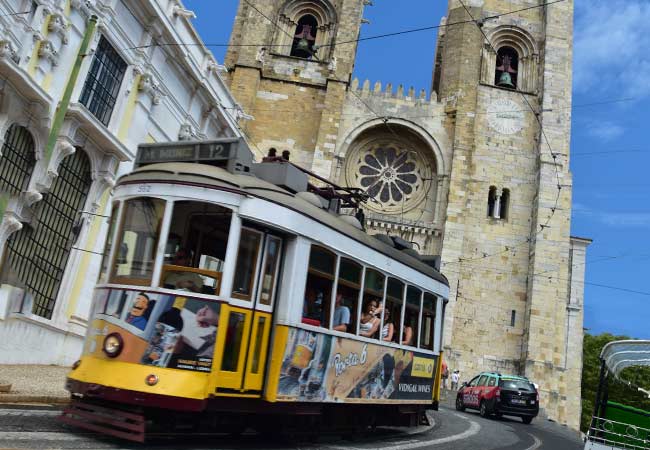
Lisbon was such so much fun

Last summer was so much fun .... x

Remeber that night in Rome

Lisbon was such so much fun

Such a view from that cathedral in Florence

Munich was eventful, wasn't it!

And we got so burnt!

Remeber that night in Rome

All we did was drink beer in Brussels...

Berlin and that group from Austria!

Can't wait to go back to Dubrovnik

Remember that boat ride in Prague

Copenhagen was a bit expensive...
